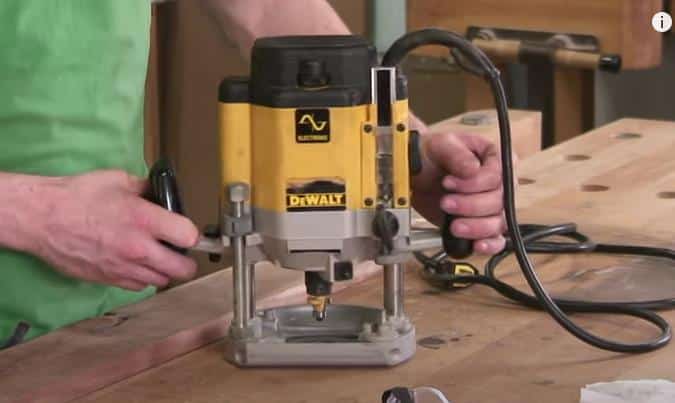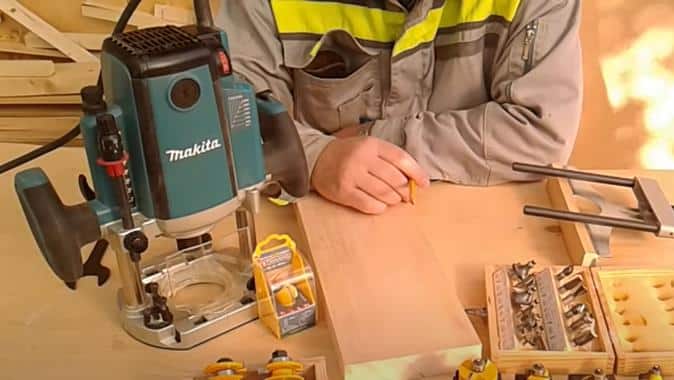A plunge router is a tool used for routing (hollowing out an area) in woodworking.
A plunge router is a handy tool that can help you make quick work of woodworking projects. But do you know exactly what is a plunge router used for?
A plunge router is a power tool used for making plunge cuts into a workpiece. It is typically used for cutting dadoes, grooves, and other specific types of cuts.
The router tool is a versatile power tool and can be used for a variety of tasks, including cutting, shaping, and routing. They are an essential tool for woodworkers and can be used to create a variety of different projects.
However, in this post, I will explore the many uses and benefits of a plunge router. And here also shared some tips for getting the most out of this powerful tool.
Read on to learn about the many possibilities a plunge router can offer you.
What Is A Plunge Router?
A plunge router is a power tool.

I think that before knowing what is a plunge router used for, it is necessary to know what a router is.
A plunge router is a type of woodworking tool that uses a spinning cutter bit to remove material from a workpiece.
Most plunge routers have a depth adjustment mechanism that allows the user to set the depth of the plunge cut. This is an important feature, as it allows the user to control the depth of the cut and avoid making mistakes.
The router typically has a motor that powers the cutter bit and is mounted on a base plate. The base of a plunge router is designed to allow the router bit to plunge into the workpiece, rather than stay flush with the surface.
Plunge routers come in many different sizes and styles and can be used for a variety of tasks such as shaping edges, cutting grooves, making mortises and dadoes, and creating decorative patterns.
What Is A Plunge Router Used For?
A plunge router is used for making cuts in wood that are not perpendicular to the grain.

A plunge router is a woodworking tool used to make precise cuts in the middle of a workpiece. It allows the user to adjust the cutting depth while the router is in motion, providing precise depth control.
Some common uses for a plunge router include:
- Creating decorative edge profiles on furniture and cabinetry
- Cutting out mortises and dadoes for joints
- Making cuts in laminates and veneers
- Creating hinge and lock mortises for doors
- Installing inlays and other decorative elements
- Flush trimming and pattern routing
- Freehand routing for sign-making and other creative projects
A plunge router is a versatile power tool that can be used for many projects and is often considered a must-have for any serious woodworker.
To use a plunge router, the cut material must be clamped down securely. The router is then positioned over the area to be cut, and the plunge mechanism is used to lower the router bit into the material.
The router is then moved in the desired direction to create the cut.
One advantage of using a plunge router is that it can be used to create very precise cuts. Plunge routers are also relatively easy to use and can be fitted with various bits to create different types of cuts.
One real-life example of where a plunge router might be used is to create an opening for an electrical outlet in a piece of wood paneling.
The paneling would be clamped down, and the plunge router would cut out the opening. This cut would be very difficult to make with a regular router.
How Do You Use a Plunging Router?
Plunge routers are great for creating cuts in materials like wood and plastic. They can also be used to round the edges of materials like wood and metal.

If you’re looking to do some serious woodworking, a plunge router is an essential tool. So far, we know what is a plunge router used for. Here’s how to use it.
To use a plunging router, you will need to follow these basic steps:
Set up the router:
Install the appropriate bit and adjust the cutting depth to the desired level. Make sure the router is securely mounted on a stable surface.
Mark the cutting area:
Use a pencil or marker to mark where you want to make cuts.
Adjust the cutting depth:
If necessary, adjust the cutting depth while the router is in motion by using the plunge lever. You’ll want to start with a shallow cut and gradually increase the depth as needed.
Begin cutting:
Turn on the router and guide it along the marked cutting area, using steady and even pressure. Keep your fingers and other body parts away from the spinning bit.
Slowly guide the router along the edge of your workpiece, taking care not to go too fast or put too much pressure on the tool. As you get more comfortable with using a plunge router, you’ll be able to go faster and take deeper cuts.
Once you’ve reached the end of the cutting area, turn off the router. And Sand the surface of the cut to remove any rough edges or burrs.
Remember, it is always vital to wear the proper personal protective equipment, such as safety glasses, dust masks, and hearing protection. And always read and follow the router’s instruction manual and safety guidelines before using it.
It’s also good to practice on a scrap piece of wood before starting your final project, get a feel for the tool, and work out any issues before cutting into your final material.
How Does A Plunge Router Work?
It has a bit that protrudes downward from the body of the router, and the bit is held at the correct depth by an adjustable stop.
Advantages Of Using A Plunge Router
There are several advantages to using a plunge router:
- Precise cuts: The ability to adjust the cutting depth while the router is in motion allows for precise control over the depth of cuts. That makes it ideal for tasks such as creating decorative edge profiles and cutting out mortises and dadoes. And it also helps make precise cuts in laminates and veneers.
- Versatility: Plunge routers can be used for a wide variety of tasks, making them a versatile tool for any woodworker.
- Safety: Plunge routers have a guard that covers the bit. This provides an extra level of safety compared to fixed base routers as it prevents accidental injuries.
- Durability: Plunge routers are built to withstand heavy use and last for many years. That for making them a worthwhile investment.
- Ease of use: Once you are familiar with the tool, plunge routers are relatively easy to use. And making them accessible to woodworkers of all skill levels.
- Increased productivity: Because of their versatility, speed, and precision, plunge routers can increase productivity. And it helps you complete projects faster and more efficiently.
- Flexibility: Plunge routers can be used with a variety of different bits, allowing you to perform different types of cuts and create different profiles.
- Starting in the middle of a workpiece: The plunge feature allows the user to start a cut in the middle of a workpiece and move outwards, which is useful for certain types of cuts like hinge mortises and inlays.
How To Choose A Plunge Router
If you want to buy perfect power tools must consider some of the important things.

When choosing a plunge router, there are several factors to consider:
- Motor size: The motor size will determine the power and speed of the router. Choose a router with a motor size appropriate for your projects.
- Speed control: Choose a router with variable speed control, which allows you to adjust the speed as needed.
- Bit size: Make sure the router can accommodate the bit size you plan to use.
- Weight: Consider the weight of the router, as a heavier router can be more difficult to maneuver.
- Ergonomics: To reduce fatigue and make using the router more comfortable, choose a router with a comfortable grip and easy-to-use controls.
- Dust collection: To keep your work area clean, find a router that has a built-in dust collection system or the capability to connect to an external dust collection system.
- Brand reputation: Look for a router from a reputable brand known for producing quality tools.
- Accessories: Some routers come with various accessories such as a parallel guide and edge guide, these can enhance your working experience.
- Price: Plunge routers vary in price, so set a budget and choose a router that meets your needs and fits within your budget.
- Warranty: Look for a router that comes with a warranty, in case of any defects or issues with the tool.
It’s also recommended to read reviews from other users and ask for recommendations from other woodworkers before making a final decision.
Related FAQ- What Is A Plunge Router Used For
What Are The Benefits Of Using A Plunge Router?
What Are Some Of The Most Popular Brands Of Plunge Routers?
Sum Up
A plunge router is a versatile power tool that can be used for a wide range of woodworking projects.
A plunge router is an important tool for any woodworker. It can cut decorative edges and make holes and grooves.
With its precise cutting capabilities and ease of use, a plunge router is a must-have for any serious woodworker looking to take their craft to the next level.
Whether you’re a professional or a hobbyist, a plunge router is sure to help you create beautiful and precise work.
So, if you’re looking to add a powerful tool to your workshop, consider investing in a plunge router today.
Hopefully, you enjoyed my latest presentation about what is a plunge router used for. If you have any questions, leave a comment below and we’ll try to answer your question.
Read More:

